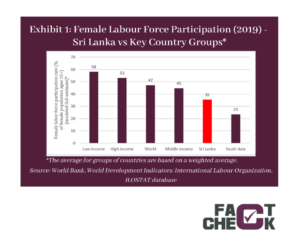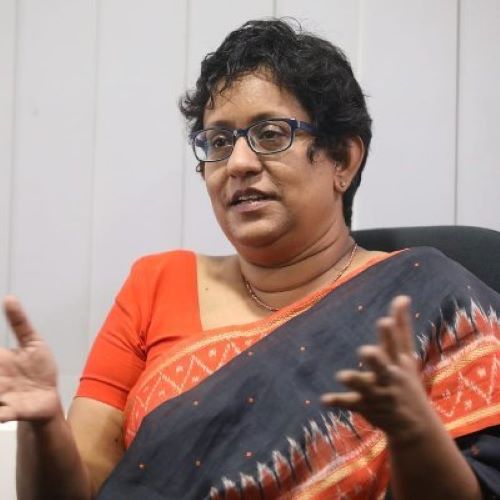Fact Check
NOTE: The full text and context suggests that MP Amarasuriya misspoke in mentioning the CBSL Annual Report date as 2009, instead of 2019. The fact check is based on 2019 data.
To assess this claim, FactCheck consulted the Labour Force Survey for Sri Lanka’s statistics and used the International Labour Organization, ILOSTAT database to compare Sri Lanka’s female labour force participation rate in 2019 with that of the rest of the world.
As claimed by MP Harini Amarasuriya, Sri Lanka’s female labour force participation rate in 2019 was 34.5% for women and 73% for men.
In South Asia, Sri Lanka has a lower female labour force participation than Nepal, Bhutan, Maldives, and Bangladesh. However, Sri Lanka’s female labour force participation rate is higher than the weighted average rate for South Asia, due to the very low labour force participation rate in India, which also has the highest population.
Even on weighted averages, Sri Lanka’s female labour force participation rate remains lower than all low-income countries, high income countries, middle-income countries (the income group Sri Lanka belongs to) and the rest of the world (see Exhibit 1).
Out of a total 187 countries and territories featured in the ILOSTAT database, Sri Lanka is ranked 161st. As such, Sri Lanka’s female labour force participation rate is ranked in the bottom 15% in the world.
These indicators affirm the claim by MP Harini Amarasuriya that Sri Lanka’s female labour force participation rate is amongst the lowest in the world.
Therefore, we classify the MP’s statement as TRUE.
*FactCheck’s verdict is based on the most recent information that is publicly accessible. As with every fact check, if new information becomes available, FactCheck will revisit the assessment.

Additional Note
The female force participation rates for the different countries taken for the above assessment may differ slightly from national estimates of each country as it is based on ILO estimates in which the measurement method has been harmonized to ensure comparability across countries and over time by accounting for differences in data source, scope of coverage, methodology, and other country-specific factors. The estimates are based mainly on nationally representative labor force surveys, with other sources (population censuses and nationally reported estimates) used only when no survey data are available. The reference periods used in labour force surveys or censuses may differ from one country to another. Differing definitions of employment age also affect comparability of data between countries.
Sources
See the MP’s full statement here: https://www.facebook.com/236859640989713/posts/260817228593954/?vh=e&extid=wIJfwzNn4QRfXjMU&d=n
Department of Census and Statistics, Labour force survey 2019, available at http://www.statistics.gov.lk/LabourForce/StaticalInformation [last accessed: 21 September 2020]
World Bank, Databank: World Development Indicators, 2020, available at https://databank.worldbank.org/reports.aspx?source=2&series=SL.TLF.CACT.FE.ZS&country= [last accessed: 27 September 2020]


